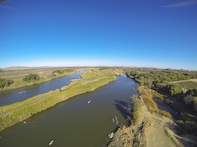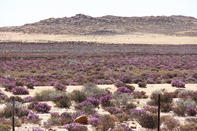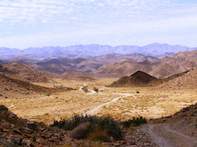Explore the Orange River

The Orange River Wine Cellars Co-op in Upington offers wine-tasting and cellar tours. The SA Dried Fruit Co-operative is the second largest and one of the most modern of its kind in the world. Tours of the plant are offered. Hand-built irrigation tunnels at Kakamas are still in use today. The Orange River Wine Cellar Co-op Rockery Route runs between Keimoes and Kakamas.
Kanoneiland town is a settlement on the biggest island in the lower Orange River region. With just about every acre under irrigation, you can visit the many vineyards and try their wines - along with a spit-roast and home-baked breads followed by any number of traditional desserts. You can even take a guided tour on the history of the island.
At Keimoes, another island, the Orange River flows at its widest. The Tierberg Nature Garden offers spectacular views of the Keimoes valley and the many islands in the Orange River. The original irrigation canal system is still in use. The Orange River Wine Cellar Co-op's largest cellar is situated here. Kenhardt is the oldest town in the Lower Orange River area. The Quiver Tree Forest and Kokerboom Hiking Trail consists of between 4 000 and 5 000 quiver trees.
The Verneuk Pan Tourist Route leads visitors to the rare phenomenon of the remains of a permanent San settlement and Sir Malcolm Campbell's track where he once attempted to shatter the land speed record.
Namaqualand

The area stretching north and west from Cape Town is an austere landscape with its own rather minimalist aesthetic. It is not appreciated much outside of the flower season. These desert and semi-desert areas do have their own appeal. The sky is open and beautiful, the distant hills and the multi-coloured rocks create their own awesome spectacle. During the annual flowering season, all pretensions to minimalism go straight out of the window.
For a few weeks during August and September, the area is a mass of colour as far as the eye can see. Superlatives don't do justice to this magnificent spectacle. The exact timing of the flowering and the very best viewing positions change from year to year and even within the season, so it is best to get the latest flower reports before heading off. The blooming of the desert is almost biblical in its proportions. Without exaggeration, you will find acres of daisies, or brightly coloured bulbs - their brilliant blooms quivering gently on long stalks.
Small pockets of delicate flowering plants create a private garden every few metres along the road, and everywhere, delicate flowers flourish for their brief but sublime moment in time. Flower enthusiasts are encouraged to pay a visit to Nieuwoudtville, a quaint country village about 400 kilometres north of Cape Town. Flower bulbs are commercially raised here, as well as growing naturally. Unofficially, Nieuwoudtville is referred to as the world’s bulb capital.
During August and September is the best time to visit, when the entire Namaqualand is in bloom with over 3,000 floral species.
Richtersveld

The far northwest of the country is remote and incredibly hot and dry. It is classified as succulent Karoo, with the neatly ranked mountains in the distance. But the truth is very different. Although trees are few and far between and quite scrubby, this is one of the most botanically interesting areas with hundreds of species of flowering succulents. The only standing water is the Orange, or Gariep River. So with no shade, virtually no roads and only one, long, linear oasis, this is not an easy place to visit. The best way to see it is on a guided river trip on the Orange River, but you could also do a guided 4x4 trail. There is a hiking trail but it's not for the fainthearted.
The Richtersveld is one of the most botanically interesting areas, with its hundreds of species of flowering succulents. Its saw-toothed mountain peak, wind-sculpted boulders and colourful indigenous flora have a unique beauty, found nowhere else on earth.